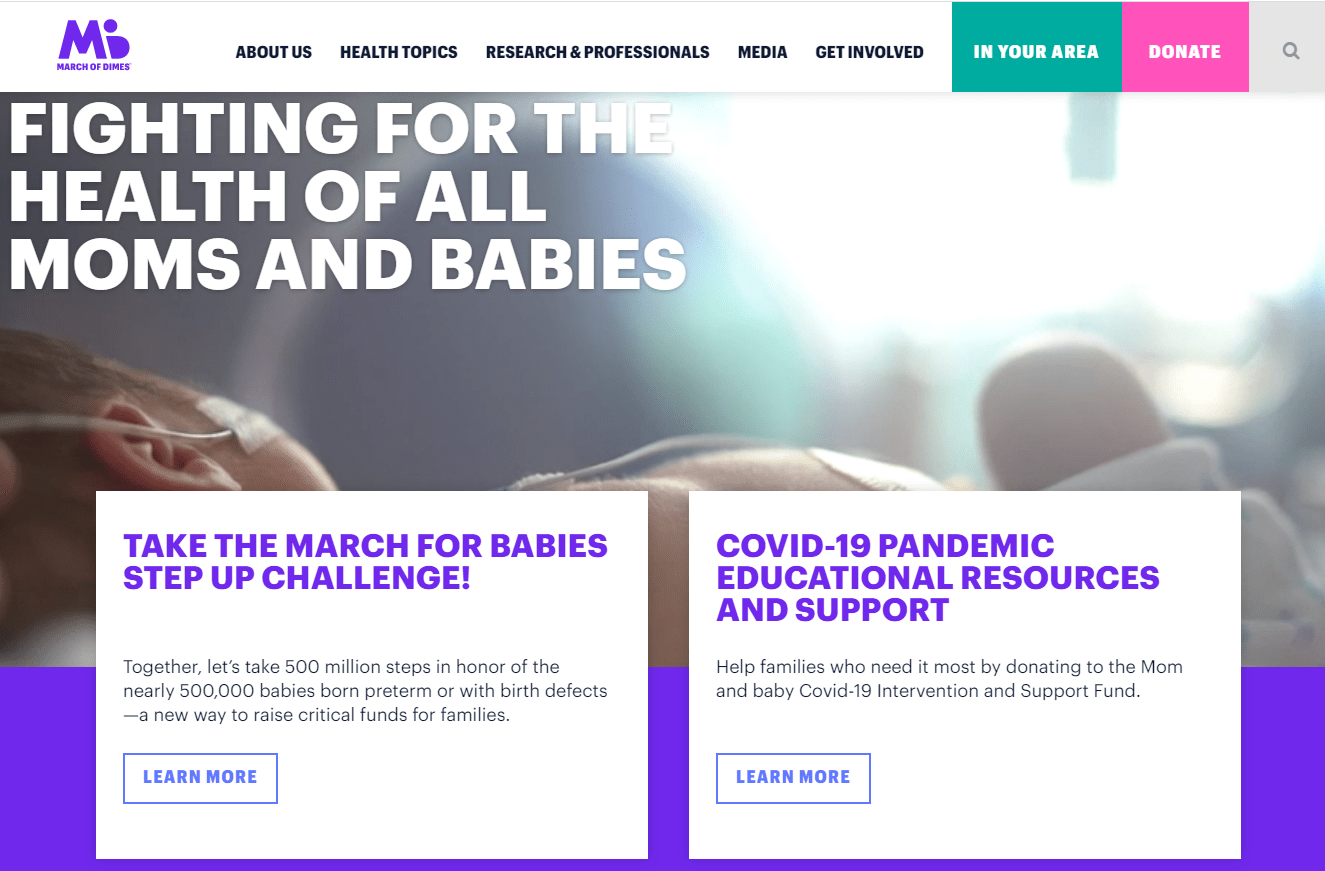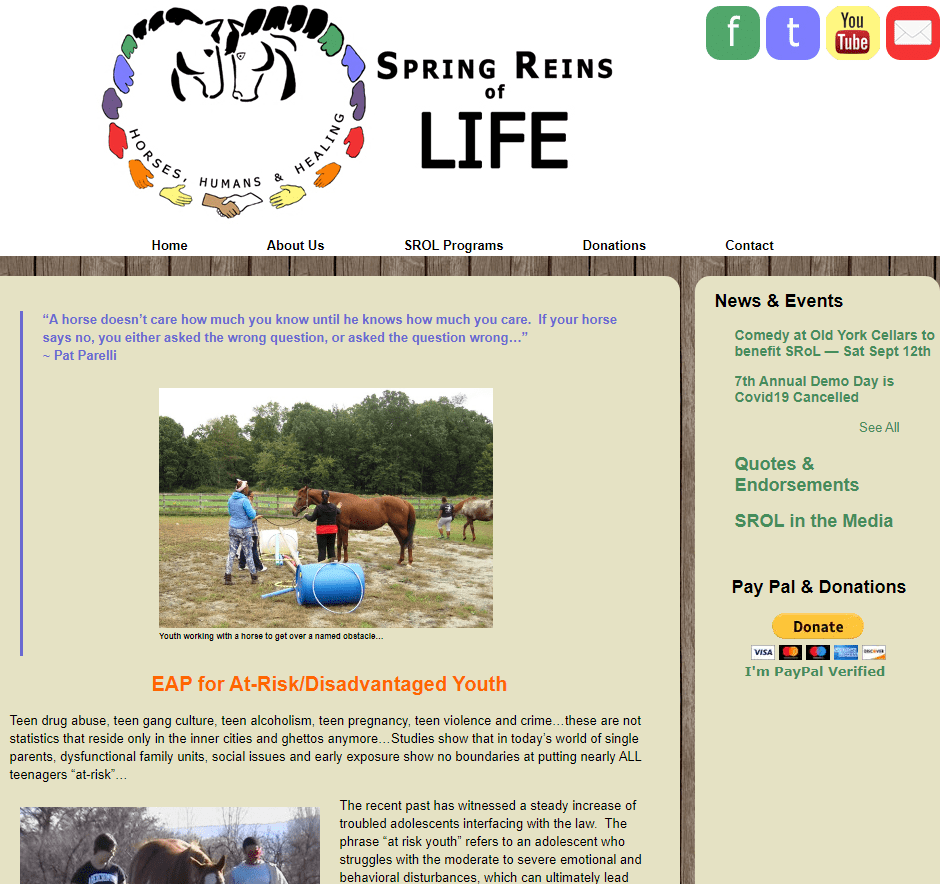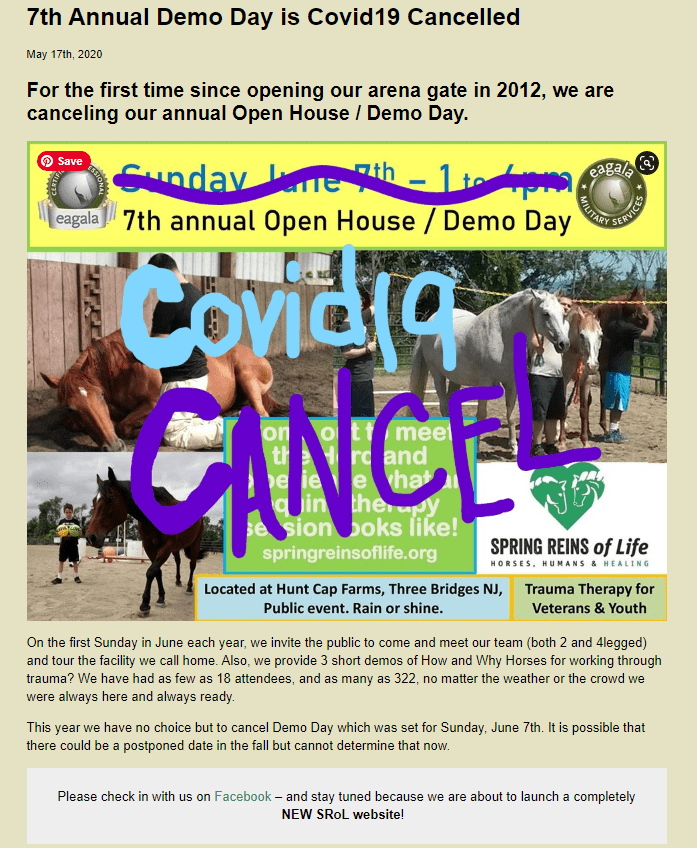Click here to read on bloomerang.
By Claire Axelrad
Nothing comes from nothing. Your organization needs a nonprofit content marketing strategy.
Replete with, dare I say it, content.
Your fundraising needs fuel.
Why?
The No-Content Problem
What if you shared this on your website, blog or e-newsletter?

Even if you slapped a “Donate” button on top, would anyone click on it?
The Lousy Content Problem
What if you shared this on your website, blog or e-newsletter?

Does this really give a clue what your organization does, or why anyone should care?
The Nonprofit Fundraising Content Conundrum
Alas, no content or lousy content is what your viewers see with much of the messaging you and/or your marketing team put out there.
- The copy is so dull it may as well be a blank screen.
- Or it’s so filled with jargon folks can’t easily comprehend it.
- Or it’s so organization-centric folks don’t think it has much to do with them or their lives.
- Or it’s the same message you’ve been spewing out for years, so it doesn’t seem relevant or capture attention.
Neal Schaffer, digital and content marketing expert, suggests such lifeless content is no better than none at all. He calls it “tumbleweed … just drifts along into nothing-ness, unnoticed.“
You may think, as a fundraiser, your nonprofit content marketing strategy is not your job. Alas, you’re wrong. Tumbleweed won’t inspire philanthropy.
Your fundraising strategy is fueled by content. Glorious, burning content that says here’s a problem and potential solution that cannot be ignored
And without that fuel, your fundraising will never catch fire.
Why Do You Need Glorious Content?
Fiery content that compels your audiences to action can yield wonderful outcomes, helping your nonprofit reach a myriad of marketing and fundraising objectives. Without it, you’ll be hard-pressed to accomplish your goals. Let’s look at why you, as a fundraiser, need to sweat the content.
1. To Get Traffic
Content drives traffic to your website. You don’t want just any traffic however. You want traffic from people likely to benefit from your content such that they take some action ultimately furthering your mission. Be sure to first spend time figuring out who your target audiences are.
Remember, nonprofits are in the “value-exchange” business. Who values what you do? There’s a whole universe of values out there, and not every one of them fits with your vision and mission. Nor does every audience. For example, people who place a high value on education will resonate with you if you’re a school. People with a burning desire to save the planet may not notice your school you no matter what you do.
You need strategic content that pulls traffic from the folks where you can make a good values match, and hopefully convert website visitors to buyers, advocates, volunteers or donors.
2. To Drive Brand Awareness
The first step of the marketing or fundraising continuum (or funnel) is awareness. If folks don’t know you exist, or don’t fully understand what you do, it’s difficult to get them involved. Small to medium-sized and local nonprofits are challenged to create awareness. Many are waiting for their big break (think “Ice Bucket Challenge“), but you have to make your own breaks. Beginning with your nonprofit content marketing strategy.
3. To Build Thought Leadership
The second step of the marketing/fundraising continuum is interest. If you’ve got superior content, and folks find you trustworthy, they’ll pay attention and engage to learn more. Of course, you don’t have to build authority on everything; just demonstrate you’re a leader in your field.
4. To Generate Leads
The third and fourth steps of the marketing/fundraising continuum are involvement and investment. Superior content gives people a reason to stick around, learn more, join your mailing list and take all sorts of other valuable actions like buying, volunteering and donating. By offering value to your audiences, you get leads as to who wants to get more engaged.
How Do You Create Glorious Content?
For content to have substance it must have direction and resonate with your target audience. They’re looking for the “good stuff,” so you better know how they define “good.” Otherwise, your content creation won’t deliver. I’m often reminded of Alice in Wonderland’s cardinal sin, so eloquently expressed to her by the Caterpillar: “If you don’t know where you’re going, any road will get you there.” Or not. If you’re merely wandering, it doesn’t matter how you get there or how long it takes.
I’m guessing you care, and your goals won’t wait for as long as it takes a monkey to plunk out a bible making random strokes on a typewriter. So let’s put some direction and purpose into your content creation.
1. Know, and Write For, Your Audience
You probably think you’re already doing this. But are you really?
CONSIDER: When’s the last time you conducted audience surveys for your target constituencies (e.g. donors, volunteers, users of services, other prospects on your mailing lists)? You should be doing this at least annually.
Why?
- People change.
- The world changes, causing changes in how people feel and behave.
- Your programs and services change in ways your audiences may be unaware.
- Your organization’s priorities change.
Think about how much you personally have changed over the past year or so. Would your year-ago self recognize you? In part, sure. But not at all in some fundamental ways. The same holds true with your supporters. You probably don’t know them as well as you think.
CONSIDER: How carefully do you monitor constituent engagement with your content (e.g., website pages visited, time spent on the page, emails opened, click-throughs, articles, blog or social media posts shared, replies, comments)? Do you know what your audience is talking about, what information they’re seeking, and how they feel about the issues with which you engage? You need to get a handle around current constituent engagement tools such as Google analytics or whatever your nonprofit CRM or email provider offer.
Why?
- To learn what your audiences do, not just what they say.
- To learn what your audiences actively search for today, not yesterday.
- To learn what compels your users to action today, not yesterday.
Remember, you goal is not simply to “create content.” There’s more than enough of the stuff out there! Your goal is to create content with the specific intention of capturing attention and interest from folks who can help you further your mission.
2. Know Your Distinct Benefits
Audiences aren’t “buying” what you do (features) so much as why you do it, and how this helps them (benefits). Benefits trump features. The help you offer folks may be intangible (e.g., through you they fulfill a moral obligation; give back to an organization that helped them or a loved one; solve a problem they agree is pressing, etc.). Or it may be more tangible (e.g., offer an entertainment, education or volunteer opportunity; share research or a “how to” list or video; provide needed services, etc.).
CONSIDER: How can you benefit your audiences in ways that distinguish you from others? There are lots of universities, hospitals, social service organizations, animal rescue operations, environmental organizations, and so forth doing good work. So what sets you apart? What’s your ‘secret sauce,’ ‘something extra,’ or ‘competitive advantage?’ Think about this carefully; you’ll want to incorporate your “secret sauce” into your content.
To get the biggest bang for your content, you’ll want to make sure it’s helpful and actionable. The point is this: It’s all about the consumer perspective. What’s in it for me? That’s what folks ask before they’ll engage with you in any way. No matter how you feel about this, it’s human nature. You can fight it, but is that the best way to accomplish your mission-central goals?
CONSIDER: What content do you have that’s beneficial? What will showcase your particular area of expertise, thus solidifying your brand? You no doubt have a lot of useful content hanging around in files, reports, and the minds of your staff. Commit to putting some of this into a shareable format. The content should be easy to read, download and use. If there are references to other resources, be sure you include operating links. Ideas include:
- “How To” tip worksheets or videos (e.g., “How to Baby-Proof your Home”)
- Recommendations (e.g., “Top Movies about Justice”)
- Recipes (e.g., “Nutritious Meals for Diabetics”)
- White Papers (e.g., “Cleaning up our Beaches”)
- Ultimate Guides (e.g., “Ultimate Guide to Home Recycling”)
- Interviews with Experts (e.g., “What our Nobel Prize winner says about Masking”)
- Advocacy Opportunities (e.g., petitions to sign; letters to forward to elected leaders; phone calls to make; rallies to join).
3. Know Who Your Audience Trusts
The best content in the world is meaningless absent credibility. If I happen on your website, and don’t know you from Adam, why would I trust what you’re saying? Good content can get a huge boost if it comes from a trusted source. This can take the form of a website testimonial (e.g., video or captioned quote + photo), an endorsing signature on an email, blog or social media post or a guest post, podcast or live event appearance.
Find out who your audiences trust. Don’t assume. Just because you think everyone admires and respects your executive director doesn’t mean they do. Just because you admire Oprah doesn’t mean your constituents agree.
CONSIDER: How can you enact strategies to figure this out?
- Test. Try sending one email from the executive director; another exactly the same from someone else (e.g., board chair, program director, community leader, celebrity, development director, and so forth).
- Monitor who your social media followers also follow. When I worked at the San Francisco Food Bank, we noticed our audience followed food and Mommy bloggers, so we reached out to these folks for endorsements.
- Ask via survey. Consider including a question in your next survey asking your peeps who they follow (social media), listen to (podcasts; news media), read (magazines, blogs, newsletters) or admire (if you have some VIPs you might be able to recruit, include these as options). You might also ask what other nonprofits they support; you could collaborate with a popular choice in an upcoming cross-promotional endeavor.
Figure out how to enlist folks your audience trusts as part and parcel of your nonprofit content marketing strategy.
CONSIDER: What strategies will put you and trusted influencers together?
- Collaborate on an event with another nonprofit; promote via email. For example, the ACLU of Northern California collaborated with the Berkeley Repertory Theater around a West Coast premiere of “What the Constitution Means to Me.” The theater offered discounted tickets, the ACLU distributed pocket constitutions, and they both emailed to their lists.
- Ask a trusted influencer to guest post on your blog. It’s also a great authority-building idea to seek out venues where you can guest post; this strategy is called reverse guest posting. You may think celebrities would be too busy, but you never know until you ask. When I worked at the San Francisco Food Bank we were able to recruit local celebrity chefs for this purpose, and even one national food writer.
- Conduct an interview with a trusted expert. Begin by making a list of experts in your field, and start as close to home as you can. Maybe it’s a doctor, lawyer, scientist or researcher on your staff; an artist, writer, performer, curator or animal keeper; or the head of a field operation. These folks are already connected to you. You might also seek out experts connected to you on social media, particularly LinkedIn.
4. Make Relevance and Timeliness Your Propellants
Content that isn’t relevant to people’s lives won’t grab attention; content that’s old will turn people off. Full stop.
Without relevance, you’re dead in the water. Without timeliness, you’ll get buried. In fact, Google seriously prefers fresh content; you need it to show up when people search. So if you’re the fundraiser, blithely ignoring what your marketing or IT team put up on your website or offer through your blog, e-newsletter or social media, you’re abdicating a huge part of your role as a philanthropy facilitator. Because no donations will be facilitated through content that’s seen as stale, dull or otherwise unconnected to what a visitor cares about.
Fundraisers have a responsibility to assure content shared with your target audiences is fresh, pertinent and meaningful.
CONSIDER: Do you know what topics related to your field are trending?
- Start by simply googling your issues to see what folks search for.
- Try a few search variations (e.g., “children at border,” “separated children,” “immigrant children,” “detained children,” “incarcerated children”) so you can use the most popular terms in your own content. When I did this, I got these results: 485,000,000; 360,000,000; 123,000,000; 34,000,000, and 23,200,000. Were I a charity working with this population, I’d know to focus my content on what’s happening “at the border.”
You may only think your responsibility extends to the donation pages; think again. Most folks land on the home page. And the content folks encounter there can make or break your fundraising efforts.
CONSIDER: What does your website home page feature right now?
- Anything past its due date, making you look inefficient?
- Anything that speaks to current events on people’s minds, sparking interest?
- Anything that speaks to what you’ve discovered folks are looking for?
- Anything that shows you can be trusted?
- Anything that offers current action opportunities?
I found the following examples more or less at random, and I’m not seeking to shame anyone. This is intended as a learning experience.
GOOD HOME PAGE EXAMPLE:
This is from the March of Dimes. First, the Home Page offers relevant, pandemic-related resources. Second, it offers a timely way to take action by marching. Third, both opportunities are current. You can even type in your zip code and find what’s happening near you by date! There’s no need to click on a menu button that says “Get Involved” or “Donate.” This content is in-your-face engaging. It’s an organization that looks happening!

POOR HOME PAGE EXAMPLE:
This is from Spring Reins of Life; I found them googling “equine therapy.” Alas, I would not have converted to a supporter based on the home page experience. First, it looks like an online brochure. This in itself is outdated. Second, the events listed on the right column are all more than a year past their “use by” date. The Sept. 12th Comedy Night was 2020; the cancelled Demo Day was 2020 and there’s nothing upcoming listed. Adding insult to injury, the bottom of the Demo Day cancellation alerts folks to ‘stay tuned’ for a new website about to be launched. What happened? Third, there’s no indication they’re doing anything in particular to respond to current top-of-mind issues like the pandemic or issues of equity and justice. Fourth, it focuses more on the problem than the solution. It’s an organization that looks old fashioned and inactive.

Spring Reins of Life outdated cancelled event, new website coming

5. Focus Content on Solutions
Don’t just talk about the problem. That’s a downer. The best way to inspire people to join with you is to demonstrate your impact. Lift folks up by sharing what you’re doing to make a positive difference. Also share how people can join with you to be part of the solution. If you don’t draw people into the solution, what’s the point?
CONSIDER: How can you solve real-life issues for your audiences? This is a donor-centered way of thinking about your content. It may not be the same thing as a commercial business selling hammers to folks who want to put nails in their walls, but it’s not unrelated. Your goal is to find your prospective donor’s need and fill it. For example:
- Are they looking to fulfill an obligation (could be moral or religious, or simply honoring or memorializing a loved one)?
- Are they fed up with something and burning to bring an end to it (e.g., homelessness in your community; immigrant family detention; incarceration of poor and BIPOC; sex trafficking; attack on voting rights, etc.)
- Are they searching for personal meaning in their life?
- Are they seeking community and belonging?
- Are they looking to leave a legacy to perpetuate their values?
Closing Thoughts
You need content or no one will know you exist. Even if folks happen to find you, they won’t give a whit. A blank or muddled canvas is a bore (okay, not if you’re an artist, but you get the idea.)
You need good content or no one will pay attention. Untargeted, targeted to the wrong audience, organization-centric, stale, dull, irrelevant content won’t inspire the actions you want people to take.
Use the “consider” questions above to figure out what content you need, your constituents want, and you can create. Come from a perspective of being helpful, and your visitors will want to return the favor!
Return to Insights & Events
